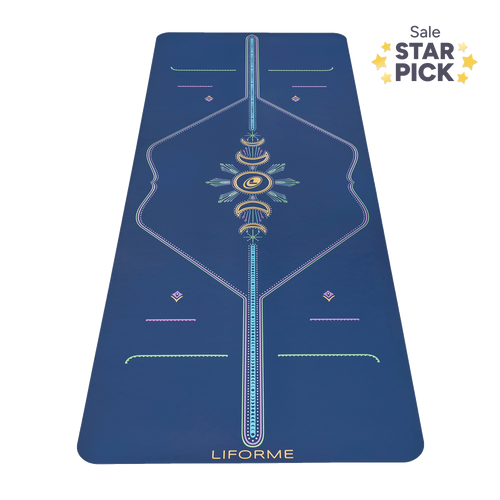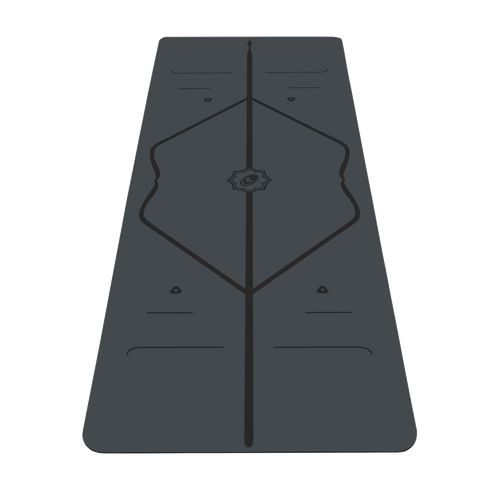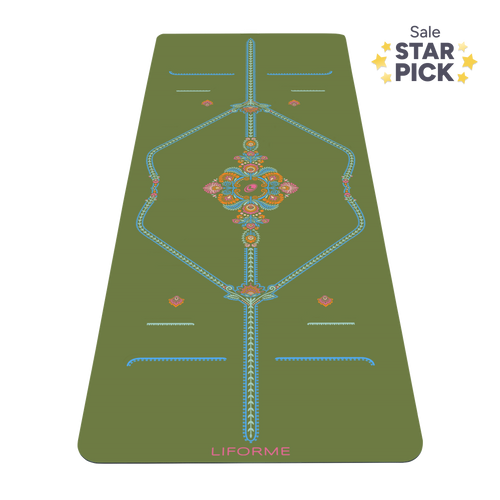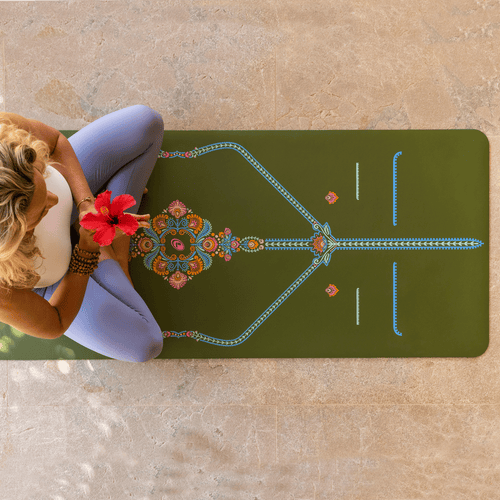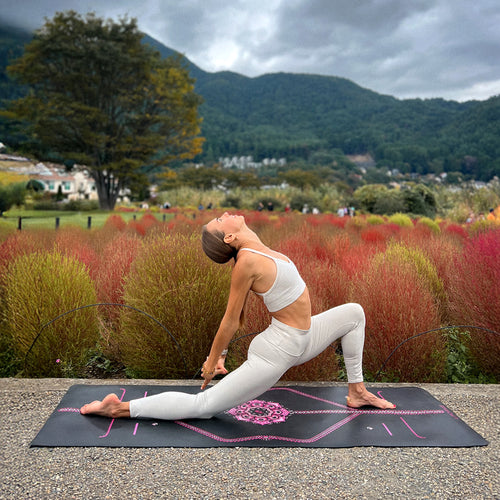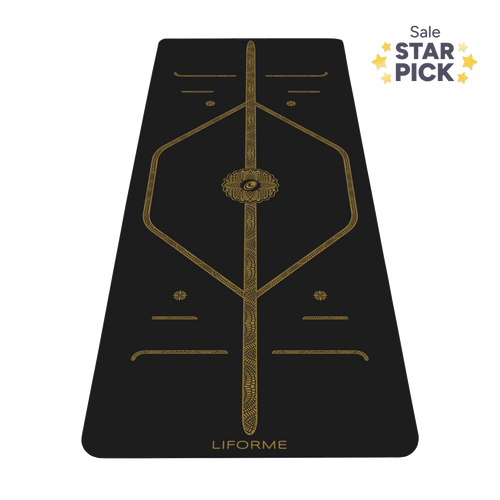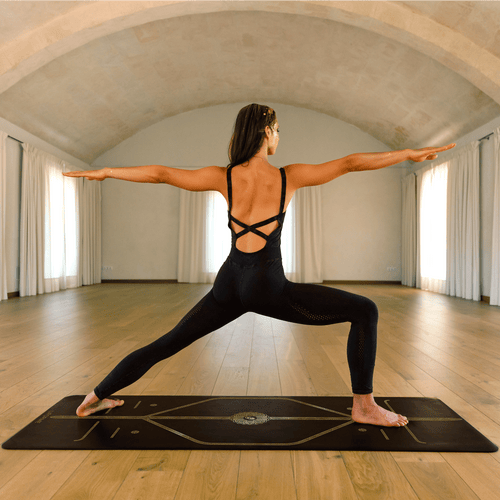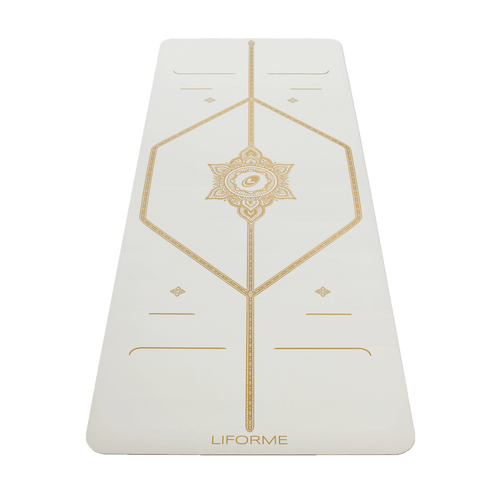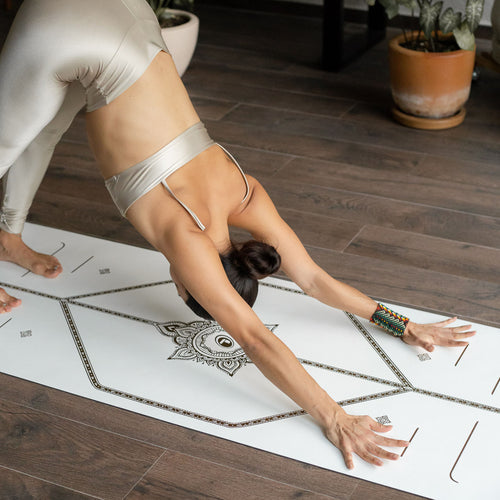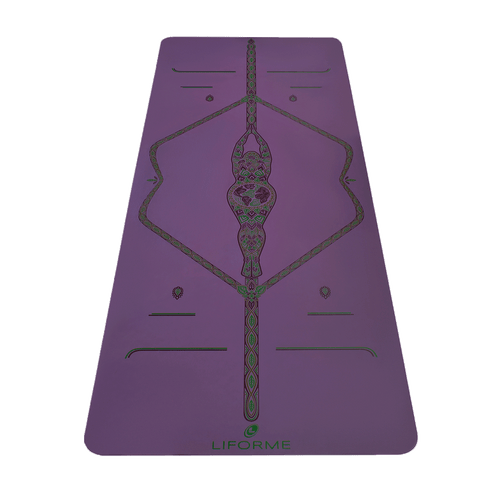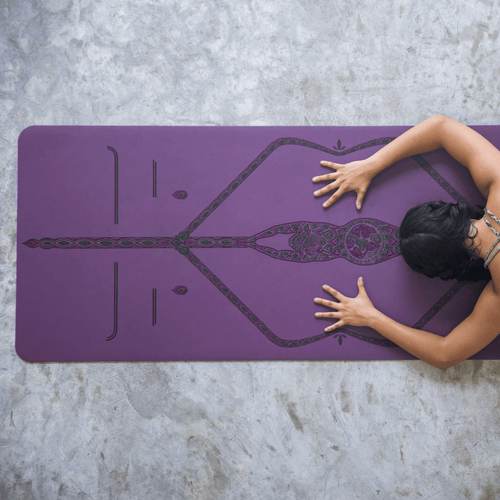Seated yoga poses include straight and cross-legged postures, forward folds, and twists. With the smart use of props, these poses suit every level and help you find safe alignment.
Try these 11 seated poses to gently loosen up the body at the start of a yoga session, then circle back to them after standing work, when you’re warm, to explore more space and depth.
🧘 Tip from a Yogi
Seated poses are ideal for improving flexibility by stretching the legs, back, and muscles around the pelvis, also known as the hips. However, sitting on the floor isn’t comfortable for everyone. If you find it difficult to sit up straight, try taking a folded blanket, bolster, or block under your bum. Raising your hips helps your spine come into a more sustainable alignment.
Seated Yoga Poses for Beginners

Staff Pose (Dandasana)
Sanskrit Meaning: Danda (Staff) Asana (Pose)
Yoga Level: Beginner
Pose Type: Seated
Why this Pose: Improves postural awareness, opens the legs, chest, and shoulders.
Alignment Insights: You’ve probably heard that Mountain Pose is the alignment touchstone for many standing yoga poses. Staff Pose is the equivalent for sitting yoga poses: an alignment baseline. Like Mountain, it looks deceptively simple but requires close attention to detail.
Step-by-Step Instructions:
1. Sit with your legs extended straight out in front of you. If your spine is rounding, elevate your seat on a prop like a blanket or a yoga block.
2. Using your hands, shift your bum to each side so that your sit bones (anatomical term: ischial tuberosity) have a firm foundation on the floor.
3. Flex both feet to engage your legs.
4. Draw your navel gently toward your spine.
5. Relax your shoulders away from your ears.
6. Press your palms to the floor on either side of your seat, but don’t let this action force your shoulders up. It’s fine to bend your elbows a little. If your full palms don’t reach the floor, it’s ok to be on fingertips, just make sure to have strong contact between your fingers and the floor. Since arm lengths vary, the arm position will be slightly different for each person.
7. Keep your neck in a neutral position with the chin neither tucked nor lifted.

Seated Forward Fold (Paschimottanasana)
Sanskrit Meaning: Paschima (West; the back of the body) Uttana (Intense Stretch) Asana (Pose)
Yoga Level: Beginner
Pose Type: Seated
Why this Pose: Stretches the back body: hamstrings, calves, glutes, and back muscles.
Alignment Insights: There are a few different schools of thought on how to forward fold in seated poses, which can be summarised by the age-old question, “to round or not to round?” It’s crucial that every forward fold is initiated as a forward tipping of the pelvis (anterior rotation), not as a flexion (rounding) of the spine. Some fold with a flat back until they can’t go farther and then round gently; keep soft and relaxed throughout.
Step-by-Step Instructions:
1. From Staff Pose, inhale to lift your arms toward the ceiling.
2. On an exhalation, forward fold over your legs by rotating the pelvis forward.
3. Come down as far as you can while maintaining a flat back. It may take several rounds of breath.
4. If you can reach your feet without rounding the spine, take hold for traction. If not, place hands by your legs or use a strap around the feet.
5. On each exhale, soften and release to let the pose deepen gradually with the breath.

Head to Knee Pose (Janu Sirsasana)
Sanskrit Meaning: Janu (Knee) Sirsa (Head) Asana (Pose)
Yoga Level: Beginner
Pose Type: Seated
Why this Pose: Stretch for the hamstrings on the extended leg and the inner thigh and hip on the bent leg.
Alignment Insights: Working one leg at a time often deepens the hamstring stretch and opens the hip of the bent leg. Keep the spine long and fold from the pelvis.
Step-by-Step Instructions:
1. From Staff Pose, bend your left knee and place the sole of your left foot on the inside of your upper right thigh.
2. Inhale to lift your arms overhead and flex your right foot.
3. On the exhale, begin to forward bend over your right leg by tipping your pelvis forward. Aim your torso over the right leg, not the space between the legs.
4. Keep a flat back by thinking “forehead to shin.”
5. Stay several breaths; hold your foot, a strap, or place hands beside your leg.
6. Inhale to sit back up and switch sides.

Thunderbolt Pose (Vajrasana)
Sanskrit Meaning: Varja (Thunderbolt) Asana (Pose)
Yoga Level: Beginner
Pose Type: Seated, kneeling
Why this Pose: Stretches the quadriceps muscles of the thighs and the tops of the feet.
Alignment Insights: A supportive alternative to cross-legged meditation. For longer sits, add a blanket between your bum and calves to maintain spinal alignment.
Step-by-Step Instructions:
1. Kneel with tops of feet flat and sit on your heels.
2. Keep balls of feet touching (or separate slightly if needed).
3. Stack shoulders over hips; maintain natural spinal curves.
4. Keep the head neutral, chin level.
5. Let the crown rise toward the ceiling.
6. Hands on thighs or take Anjali mudra at your heart.

Easy Pose (Sukhasana)
Sanskrit Meaning: Sukha (Ease) Asana (Pose)
Yoga Level: Beginner
Pose Type: Seated, hip opener
Why this Pose: A simple cross-legged seat that supports breathwork, meditation, and spinal alignment.
Alignment Insights: Aim for knees lower than hips so the pelvis can tip slightly forward. Sit on a folded blanket, firm cushion, or thin block if the back rounds or hips feel tight.
Step-by-Step Instructions:
1. Sit in a comfortable cross-legged position (feet tucked or staggered).
2. If knees sit above hips, raise your seat with a prop.
3. For longer sits, switch the crossing of your legs halfway through.

Cobbler’s Pose (Baddha Konasana)
Sanskrit Meaning: Baddha (Bound) Kona (Angle) Asana (Pose)
Yoga Level: Beginner
Pose Type: Seated, hip opener
Also Known As: Butterfly Pose, Bound Angle Pose
Why this Pose: A hip opener that stretches the inner thighs from a stable seat.
Alignment Insights: Raise the hips if your spine rounds; blocks under knees can add support.
Step-by-Step Instructions:
1. Sit with knees wide and soles of the feet together.
2. Press outer feet; optionally open feet like a book if knees allow.
3. Inhale to lengthen the spine.
4. Exhale to hinge from the hips, drawing the navel toward the feet.
5. Deepen only while keeping the spine long.
Seated Yoga Poses for Intermediate & Advanced Yogis

Half Lotus (Ardha Padmasana)
Sanskrit Meaning: Ardha (Half) Padma (Lotus) Asana (Pose)
Yoga Level: Beginner - Intermediate
Pose Type: Seated, hip opener
Why this Pose: Opens the hips; stretches the feet and ankles.
Alignment Insights: A progressive step toward Lotus that builds hip external rotation; avoid any knee pain.
Step-by-Step Instructions:
1. From Staff Pose, bend the right knee and place the right foot on the floor near the right sitting bone.
2. Use your hands to place the right foot atop the left thigh close to the hip crease; sole faces up; toes active.
3. Bend the left knee into a cross-legged position and tuck the left foot under the right knee.
4. Breathe 5–10 breaths; switch sides.

Lotus Pose (Padmasana)
Sanskrit Meaning: Padma (Lotus) Asana (Pose)
Yoga Level: Advanced
Pose Type: Seated, hip opener
Why this Pose: Opens the hips; stretches the feet and ankles.
Alignment Insights: If Half Lotus is comfortable, try full Lotus. Traditionally right leg first; alternate sides for balance.
Step-by-Step Instructions:
1. From Half Lotus (right leg tucked), bring the left heel close to the left buttock with the knee bent and sole on the floor.
2. Use hands to place the left foot near the right hip crease; soles face up; feet active.
3. Hold 5–10 breaths, then release and switch the crossing.

Half Lord of the Fishes Pose (Ardha Matsyendrasana)
Sanskrit Meaning: Ardha (Half) Matsyendra (Lord of the Fishes) Asana (Pose)
Yoga Level: Beginner
Pose Type: Seated twist
Why this Pose: Stretches the upper back, side body (serratus anterior and erector spinae), and pelvic muscles, including the piriformis.
Alignment Insights: The lumbar spine is not built for rotation; twist from the thoracic and cervical spine.
Step-by-Step Instructions:
1. From cross-legged, draw your left knee toward midline and place the right foot outside the left thigh, right knee up.
2. Inhale, lift both arms; exhale, twist right. Right hand behind you; left elbow outside right knee.
3. Brighten through left fingertips; press right foot firmly.
4. Inhale lengthen; exhale deepen. Gaze over right shoulder or keep nose aligned with navel.
5. Hold 5–10 breaths; switch sides.

Cow Face Pose (Gomukhasana)
Sanskrit Meaning: Go (Cow) Mukha (Face) Asana (Pose)
Yoga Level: Intermediate
Pose Type: Seated hip and shoulder opener
Why this Pose: Stretches the upper arms, back muscles, glutes, and outer thighs.
Alignment Insights: Often uncomfortable at first; sit on a folded blanket and use a strap for the bind if needed.
Step-by-Step Instructions:
1. From cross-legged, stack right knee over left and place feet beside opposite hips; prop up if needed.
2. Inhale, lift right arm; bend elbow; drop right hand down the back. Use left hand to guide right elbow toward midline.
3. Bring left arm down, bend elbow, and reach up the back to clasp hands or strap.
4. Draw both elbows toward midline; gently press head into right arm.
5. Hold, then switch sides.

Compass Pose (Parivrtta Surya Yantrasana)
Sanskrit Meaning: Parivrtta (Revolved) Surya (Sun) Yantra (Instrument) Asana (Pose)
Yoga Level: Advanced
Pose Type: Seated twist
Why this Pose: Stretches the hamstrings, hips, and shoulders.
Alignment Insights: Advanced posture—take it step by step and stop where needed.
Step-by-Step Instructions:
1. From a cross-legged position, draw your left foot in towards your chest with both arms.
2. Thread your left arm under your left leg and place your left fingertips on the floor outside your left hip.
3. Use your right hand to guide your left knee over your left shoulder. Grip the outside edge of the left foot with the right hand.
4. Simultaneously straighten your left leg and right arm to pull your shoulders and head through the opening between the left leg and right arm as you twist the chest open to the right side.
5. Take your gaze upwards and stay active through the left toes.
6. Breathe steadily for several cycles, then release with control and switch sides.
Benefits of Seated Yoga Poses
- Improves flexibility
- Stretches the legs (hamstrings, quads, and calves)
- Lengthens and stretches the back muscles
- Opens the muscles around the pelvis and hips
- Provides a stable base that facilitates deeper stretching
Why Do We Practice Seated Poses?
There is a place for seated yoga poses in every practice. If you find them uncomfortable now, remember that consistent practice brings improvements in flexibility over time. Use plenty of props along the way.
Some people prefer more active postures because they feel like they are doing more. Slowing down with seated poses provides an important counterpoint, both mentally and physically. No yoga pose is ever static, and each has a role in building a healthy, sustainable practice.
Seated Yoga Poses FAQs
What props should I use to sit comfortably in seated yoga poses?
Use a folded blanket, firm cushion, yoga bolster, or block under your seat. Aim for knees lower than your hips so the pelvis can tip forward while the spine stays long.
How long should I hold seated poses?
Start with 5-10 slow breaths. In gentler shapes (e.g., Sukhasana, Baddha Konasana), you can stay longer if your alignment is sustainable and your breath remains easy.
Where should seated poses go in my practice?
You can start your practice with seated poses as a warm-up and return to them at the end after standing sequences when you’re warm.
I have tight hamstrings. What should I modify in seated poses?
Elevate your seat, bend your knees slightly, and/or use a strap around the feet in forward folds to maintain a long spine.
Are seated yoga poses safe for people with lower-back sensitivity?
Many seated poses can be done safely, but use caution when forward folding. Sit on a prop to raise your hips and keep your spine long. Never force a forward fold and come out if you feel any pain.
Are there any pregnancy considerations in seated yoga poses?
Avoid deep, compressive forward folds and long, closed twists. Elevate the seat, create space around the abdomen, and consult your healthcare professional.
What are some common mistakes in sitting poses?
Rounding from the mid-back instead of hinging at the hips is the most common pitfall in seated yoga poses. Avoid chasing depth by yanking on the feet, and don’t ignore knee pain in cross-legged positions like Lotus.
Do I need a specific mat for seated yoga work?
A grippy, supportive mat that cushions the sit bones without squishing is helpful for longer holds and stable alignment.






